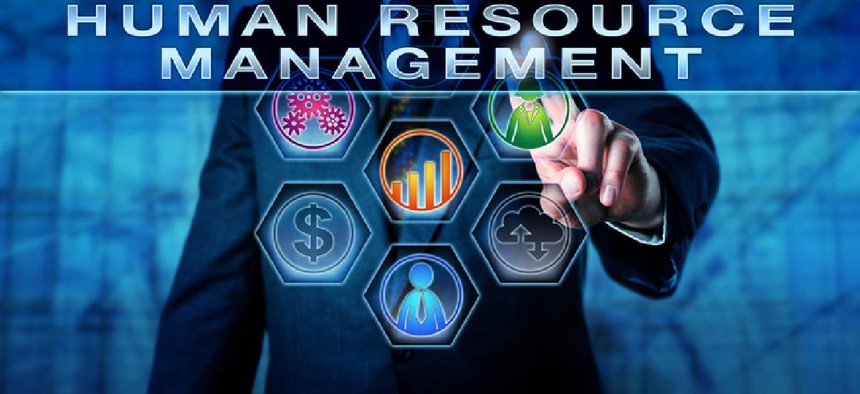The workforce and mission arguments for modernizing human capital management systems

HCM software can help improve efficiency through self-service and automation, enable HR to better understand and address employee wellbeing and engagement, and prepare for the future while aligning people resources with the organization’s mission today.

The pandemic caught many organizations off guard, including government agencies. When those agencies made the rapid transition to remote work, it revealed huge infrastructure gaps, strained IT capacity and underscored the lack of integration between on-premises and cloud-based systems used to conduct business at every level of government.
HR was especially hard hit. Many federal HR professionals already had recruiting challenges and new reporting requirements on their plate, including those related to the gender pay gap and diversity, equity and inclusion (DE&I) initiatives. With the necessity to manage employee furloughs at some agencies and handle new health and safety concerns, the pandemic added to their workload.
As the pandemic recedes, new priorities are emerging, and HR will need better technology to handle them. The competition for highly skilled employees is on again now that hiring freezes are over, and agencies need better access to employee data to staff urgent projects and foster a diverse workforce , as well as provide modern tools to support organizational agility and increase employee engagement.
IT can support HR with technology that delivers the human capital management tools needed to meet these challenges. When IT leaders modernize HCM software, it not only has a positive effect in HR, it improves the employee experience overall and can drive needed change across the agency.
How modern HCM software up-levels the entire organization
IT has a key role to play as their organizations accelerate digital transformation, and modern HCM software can help by integrating data across the agency and creating new efficiencies that help HR manage the entire employee lifecycle. Here are some of the ways modern HCM software can help government organizations thrive:
- Automation and self-service: Providing self-service capabilities and automating back-office tasks improves workflows and upgrades the employee experience. At government agencies, the time employees spend gathering, cleansing and entering data or performing other tasks that don’t directly add value is time they can’t spend serving the public. HCM software gives staff more time to focus on what’s truly important.
- Project-people alignment: With an HCM system that focuses on skills instead of roles, managers can instantly identify employee abilities that fall outside the scope of their present job description, such as the ability to speak multiple languages or write code. This can help the agency respond to urgent projects more quickly and put people where they can make the most impact, which improves organizational performance and employee satisfaction.
- Skills development: According to Gartner, only 16% of new hires have the skills needed for their current and future roles. HCM software can help agencies identify the skills gaps that exist today and also plan for capabilities that will be needed in the years ahead. That helps HR manage employee development and upskilling more proactively, making the agency more resilient and better prepared for the future.
- Learning programs: Agencies must often develop expertise that isn’t available in-house. An HCM system that allows HR to create custom career development paths and training modules using outside experts and content creators can transform learning programs so that the agency addresses current and future needs.
- Engagement and performance: HCM software that facilitates one-on-one conversations between managers and employees can keep staff members closely connected. The technology can also track performance and goals and streamline access to training so employees can grow within the organization rather than looking for opportunities elsewhere.
Software that integrates with other systems eliminates error-prone manual data entry and reporting processes, improving efficiency and accuracy. HCM software that helps the agency be proactive instead of reactive also puts real-time data at decision-makers’ fingertips, enabling organizational agility.
The business case for an employee engagement upgrade
One reason to upgrade HCM technology is to improve workers’ commitment and connection to the organization. People are more values-driven today, and the current job market is favorable for workers, so competition is growing. That’s why employers across industries identify employee engagement as a top goal.
New funding from massive federal relief packages also gives government IT leaders a rare opportunity to replace legacy technology. That should include the tools HR uses for recruiting and retaining valuable staff. Governments and businesses alike have embraced digital transformation, and the pandemic largely settled the argument about migrating operations to the cloud.
However, the business case for upgrading the employee experience in government goes deeper than that. Agencies must respond to change quickly, and retooling for the post-pandemic workplace provides a new opportunity to address technology, skills and employee experience gaps that have made recruiting and retaining government employees a challenge for decades.
HCM software can help improve efficiency through self-service and automation, enable HR to better understand and address employee wellbeing and engagement and prepare for the future while aligning people resources with the organization’s mission today. That’s how HCM software can empower HR.
In addition to giving HR the tools to manage talent more effectively, HCM software can empower employees to develop to their full potential by fostering stronger connections with managers, creating a culture where work is more meaningful and aligning projects with skills. And that’s how government IT leaders can use HCM technology to drive broader organizational change.
NEXT STORY: VA Halts Health Records Deployments Through 2021





